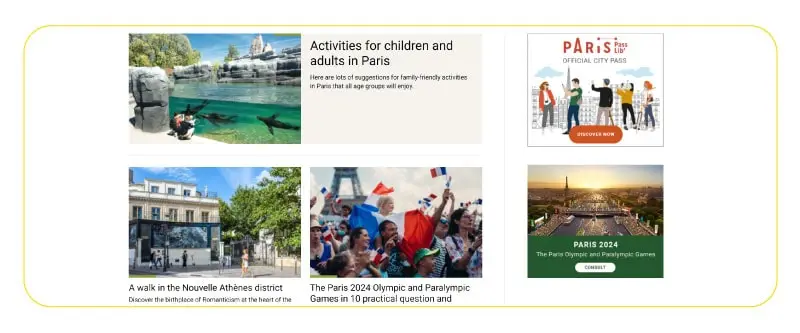Native advertising has revolutionized the way businesses reach their target audience online. Unlike traditional advertising methods, native advertising blends seamlessly with the content of a website or social media platform, making it less intrusive and more engaging for the reader. As a result, native advertising has become one of the most effective ways to promote products and services, drive traffic to a website, and build brand awareness.
But do you know how to create a successful native advertising campaign? In this article, we’ll walk you through the key elements that make up a successful native advertising campaign, from defining your objectives to designing effective ad placements. Whether you’re a small business owner looking to reach a new audience or a seasoned marketer seeking to optimize your advertising strategy, this guide has everything you need to create a native advertising campaign that delivers real results.
Define your objectives first
Before diving into the nitty-gritty of creating a native advertising campaign, it’s important to define your objectives. A clearly defined objective sets the foundation for a successful campaign and helps you measure its success. Your objectives should be specific, measurable, attainable, relevant, and time-bound (SMART). For example, if you’re a new e-commerce store, your objective might be to drive traffic to your website and generate leads. To achieve this objective, you might set a goal of increasing website traffic by 25% and generating 50 new leads per month through native advertising.
Defining your objectives also helps you choose the right platform for your campaign. For example, if your objective is to increase brand awareness, you might choose a platform like Facebook or TikTok, which have a large user base and offer targeting options based on demographics and interests. On the other hand, if your objective is to drive traffic to your website, you might choose a platform like Outbrain or Taboola which specialize in driving traffic through content recommendations.

By defining your objectives upfront, you can create a native advertising campaign that is laser-focused on achieving your goals, and measure your success along the way. So, take the time to define your objectives before you dive into creating your campaign, and set yourself up for success.
Research your intended audience
When it comes to creating a successful native advertising campaign, understanding your target audience is key. You want to create content that resonates with your audience and speaks to their interests and pain points.
To start, use data-driven insights to research your target audience. You can use tools like Google Analytics, social media analytics, or customer surveys to gather information about their demographics, interests, behaviors, and preferences. Another great solution would be taking advantage of a native ad spy tool like AdFlex to find out which creative resonate more with audiences in your niche and which audiences are being targeted by your competitors.

Once you have a good understanding of your target audience, create buyer personas that represent them. A buyer persona is a fictional representation of your ideal customer that includes details like age, gender, occupation, goals, challenges, and motivations.
By creating buyer personas, you can tailor your native advertising campaign to appeal to specific segments of your target audience. For example, if you’re a health and wellness brand targeting millennials, you might create a buyer persona named “Yoga-loving Millennial” who is interested in plant-based diets, sustainable living, and mindfulness practices. With this persona in mind, you can create native advertising content that speaks directly to this audience’s interests and values.
By understanding your target audience and creating buyer personas, you can create a native advertising campaign that resonates with your audience, drives engagement, and ultimately leads to conversions.
Picking the right platform for your native ads
Choosing the right platform for your native advertising campaign is critical to its success. Different platforms offer different targeting options, ad formats, and user demographics, so it’s important to choose the one that best aligns with your campaign objectives and target audience.
One of the most popular platforms for native advertising is Facebook. With almost 3 billion active users, Facebook offers a vast audience and precise targeting options based on interests, behaviors, and demographics. You can also choose from a variety of ad formats, including sponsored posts, stories, and videos, and set a budget that works for your business.

Another popular platform for native advertising is Instagram. With over 1 billion monthly active users, Instagram offers a highly engaged audience that is particularly popular among younger demographics. You can create sponsored posts, stories, and reels that blend seamlessly with organic content and use targeting options based on interests, behaviors, and demographics to reach your ideal audience.
If you’re looking to drive traffic to your website, platforms like Outbrain and Taboola specialize in content recommendations that drive clicks to your website. These platforms use algorithms to recommend your content alongside relevant articles on high-traffic websites, driving qualified traffic to your website and increasing your brand’s visibility.
By choosing the right platform for your native advertising campaign, you can reach your target audience more effectively, increase engagement, and ultimately drive conversions. So, take the time to research your options and choose the platform that best aligns with your campaign objectives and target audience.
Preparing the content of your native ads
Once you have defined your objectives, understand your target audience, and picked the appropriate platform for your ads, the next step is to create compelling native advertising content that resonates with your audience.
The key to creating effective native advertising content is to make it informative, entertaining, and valuable to the reader. Your content should blend seamlessly with the website or social media platform it appears on, and offer something of value to the reader, whether it’s educational information, entertainment, or a special offer.

One approach to creating effective native advertising content is to tell a story that resonates with your audience. People love stories, and when done right, storytelling can be a powerful tool for building brand awareness and engaging your target audience. For example, if you’re a travel company, you might create a native advertising campaign that tells the story of a couple who took a romantic trip to Paris and stayed in a luxurious hotel. The content could include beautiful images of the hotel and Paris, tips on what to see and do in the city, and an offer for a discount on hotel bookings.
Another approach is to create content that taps into the emotions of your audience. People are more likely to engage with content that elicits an emotional response, whether it’s humor, nostalgia, or inspiration. For example, a coffee company might create a native advertising campaign that features heartwarming stories of people sharing a cup of coffee with loved ones, or humorous content that pokes fun at the morning coffee routine.
By creating compelling native advertising content that resonates with your audience, you can build brand awareness, drive engagement, and ultimately lead to conversions.
Monitoring and optimizing campaign performance
Once your native advertising campaign is up and running, it’s essential to monitor its performance and make adjustments as needed to ensure it meets your objectives. This process of continuous optimization is critical to the success of your campaign and can help you get the most out of your advertising budget.
A key metric to monitor is engagement. Engagement metrics such as likes, comments, shares, and click-through rates can provide valuable insights into how your audience is interacting with your content. By monitoring these metrics, you can determine which types of content are resonating with your audience and make adjustments to your campaign accordingly.
Another important metric to monitor is conversions. Whether you’re looking to generate leads, sales, or downloads, it’s essential to track the number of conversions your campaign is generating. By monitoring conversions, you can determine which ad formats, targeting options, and content types are driving the most conversions, and optimize your campaign accordingly.

In addition to monitoring metrics, it’s essential to test and optimize your campaign on an ongoing basis. A/B testing is an effective way to test different variations of your ads and landing pages to determine which version performs better. By testing different ad formats, messaging, and images, you can optimize your campaign for maximum engagement and conversions.
Finally, don’t be afraid to make adjustments to your campaign mid-way through. If you notice that your campaign is not performing as expected, don’t hesitate to make changes to your targeting options, ad formats, or messaging. By continuously monitoring and optimizing your campaign, you can improve its performance over time and get the most out of your advertising budget.
Monitoring and optimizing your native advertising campaign is crucial to its success. By monitoring engagement and conversions, testing different variations of your ads, and making adjustments as needed, you can optimize your campaign for maximum performance and get the most out of your advertising budget.
Conclusion
Creating a successful native advertising campaign requires a strategic approach that aligns with your business objectives and resonates with your target audience. By following these steps – defining your objectives, understanding your target audience, creating compelling content, choosing the right platform, and monitoring and optimizing your campaign – you can build brand awareness, drive engagement, and ultimately achieve your advertising goals. Remember, native advertising is about blending in, not standing out, so make sure your content is informative, valuable, and relevant to your audience. With the right approach, native advertising can be a powerful tool for reaching your target audience and driving conversions.
FAQs
How can I make my native advertising campaign stand out?
To make your native advertising campaign stand out, focus on creating high-quality, informative content that provides value to your target audience. Use eye-catching visuals and headlines to grab their attention and make sure your content aligns with the platform’s natural content.
How can I choose the right platform for my native advertising campaign?
To choose the right platform for your native advertising campaign, consider your target audience, objectives, and budget. Research different platforms and their audience demographics, ad formats, and pricing options to find the best fit for your campaign.
How do I monitor and optimize my native advertising campaign?
To monitor and optimize your native advertising campaign, track engagement metrics such as likes, comments, shares, and click-through rates, as well as conversion metrics such as leads and sales. Test different variations of your ads and landing pages using A/B testing and make adjustments as needed to optimize your campaign for maximum performance.
How can I ensure my native advertising campaign is compliant with regulations?
To ensure your native advertising campaign is compliant with regulations, such as the Federal Trade Commission’s guidelines, clearly label your content as sponsored or advertising. Avoid using deceptive or misleading tactics and make sure your content provides value to the audience.







 Facebook Ads Spy Tool
Facebook Ads Spy Tool TikTok Ads Spy Tool
TikTok Ads Spy Tool